Revisiting Value Capture
Bargaining & Value Capture
Any firm, whether it produces products or services, transforms some inputs into outputs. Inputs typically range from raw-materials, labour, intermediate products, consumables. Firms acquire the inputs from their suppliers in upstream markets and deliver their products or services to their direct customers in downstream markets.
The transformation process may also require Capital Equipment, items (e.g. machinery, intellectual property) that are not transformed in the process and can be used repeatedly.
For B2C (Business to Consumers), customers are the final consumers of the products, whereas B2B (Business to Business firms deliver their products to other firms.

Total Created Value
We start with an over-simplified case where there is a single supplier providing the goods, a single firm and a single customer acquiring the product.
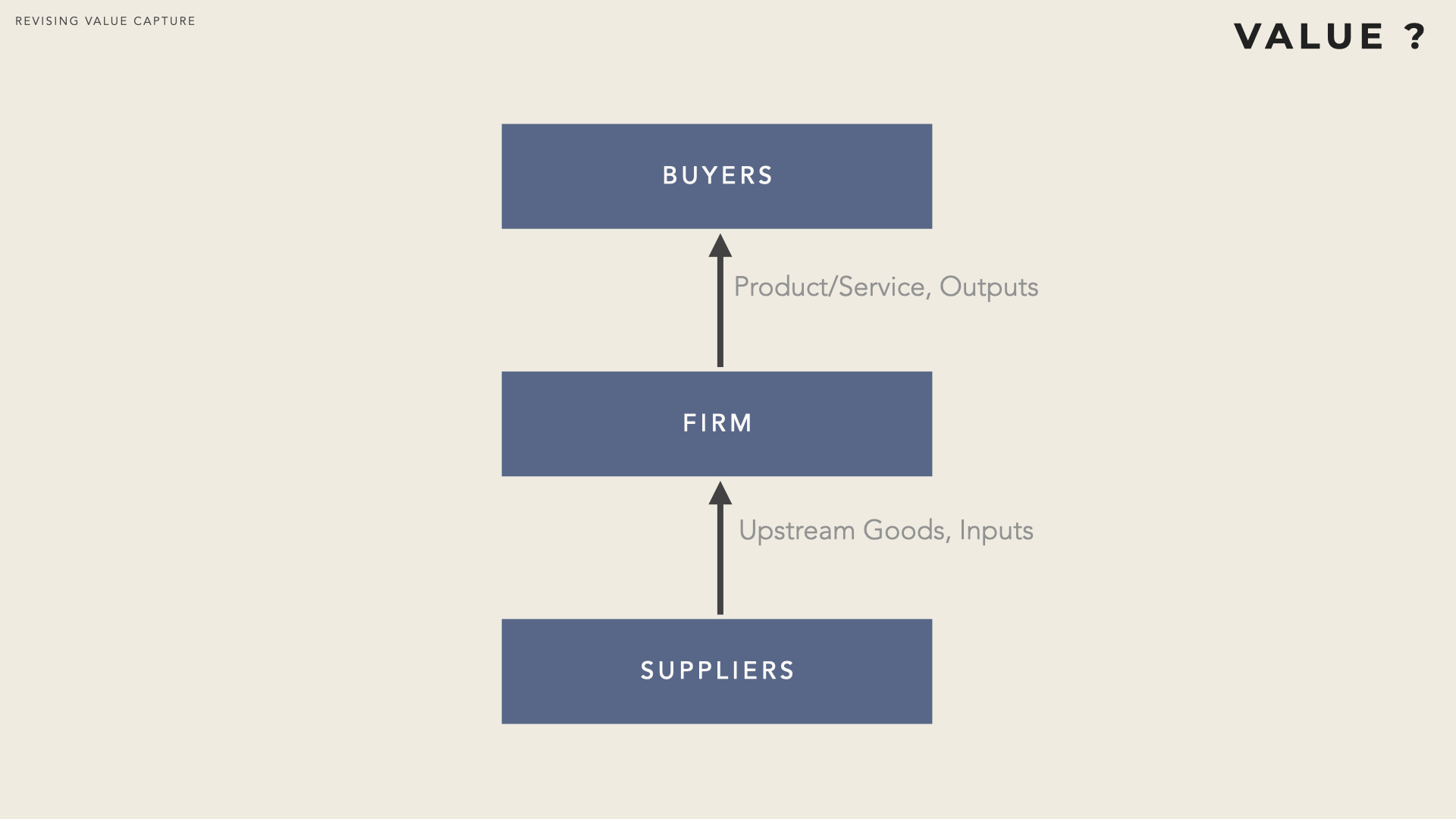
The actual price at which the product is sold and the actual price received by the supplier for the goods result from the bargaining between the customer and the firm on the one hand and between the firm and the supplier on the other. However two pivotal concepts, the willingness to pay and the willingness to sell.
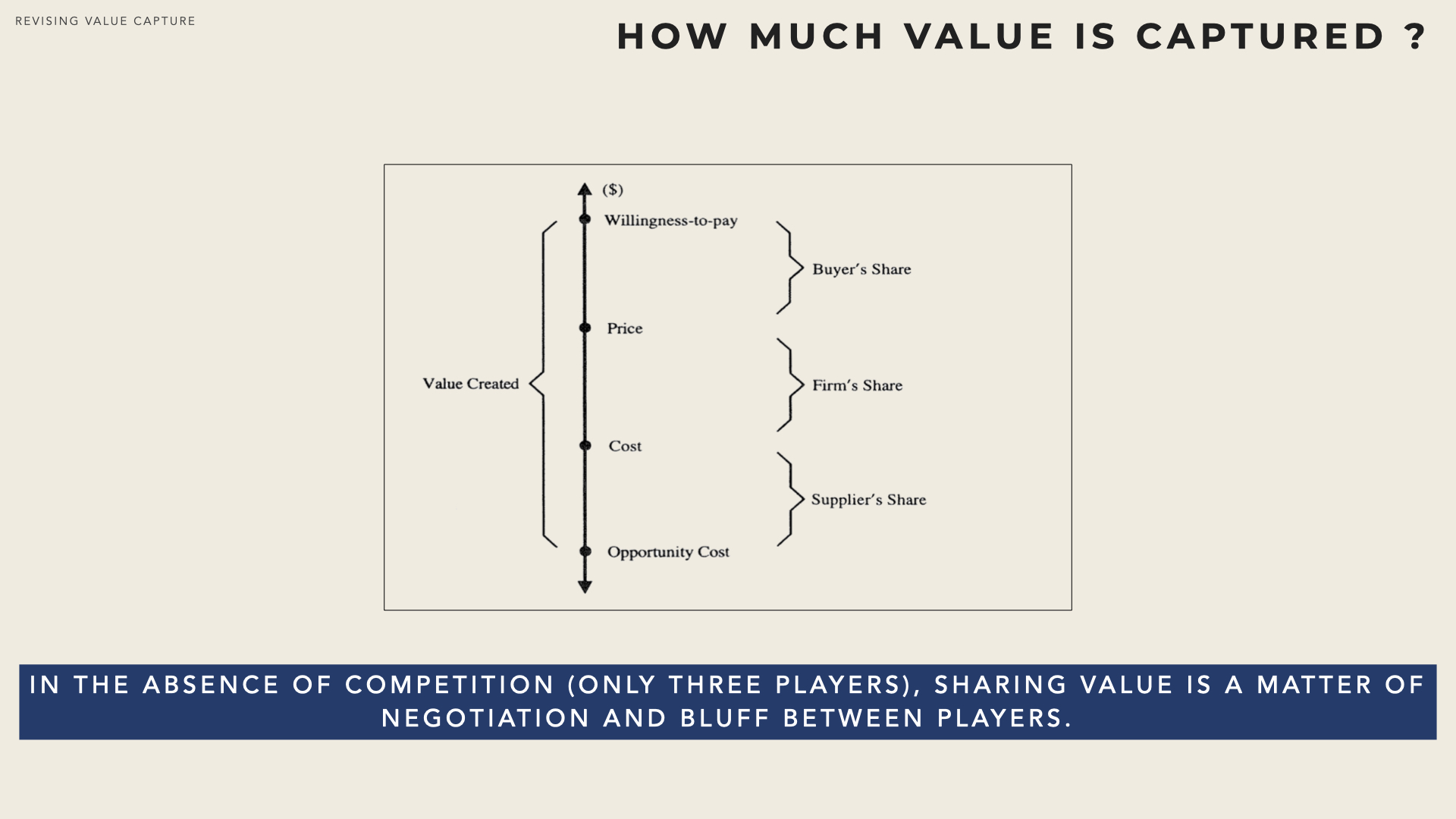
Opportunity Cost
The situation from the supplier’s perspective is symmetrical to that of the customer: the Willingness-to-sell (aka willingness-to-accept, reservation price) is the amount for which the supplier is indifferent between selling or not selling. A supplier would accept any price higher than the willingness to sell, but would reject any lower offer.
The willingness-to-pay is also the opportunity cost of selling, that is the value which is given up when the good is sold. The opportunity cost is the cost (loss of potential gain)incurred by not enjoying the value (utility) associated with the best alternative to selling the good.
The employment of resource services in any manner involves a cost to the resource owners. This cost consists in their own evaluation of forgone alternatives, an evaluation made at the moment of commitment. J. Buchanan.
Ross Gittins ( [Gittins] ) the Economics Editor of The Sydney Morning Herald, stresses that the concept of Opportunity Cost while foundational to microeconomics can be misleading and even economists can get it wrong.
The opportunity cost of a decision is the value (utility) of the next-best alternative. Imagine you win a free ticket (that cannot be resold) to see an Eric Clapton. On that same day, there is a Bod Dylan concert priced $40, knowing that you would usually be ready to pay $50 to see Dylan in concert. Going to Dylan’s concert is your best alternative to Clapton’s concert. What is the opportunity cost of going to Clapton’s concert ? $10 as you are forgoing $50 utility net from $40 costs.
Note As stressed by Brandburger & Harborne, there must be well defined prices elsewhere in the economy (i.e. outside the modeled vertical chain) to allow the assessment of the willingness to pay and willingness to sell.
In the case of a “system” made up of several players at each level, on the total value created (by the system) is \[ V = max(WTP) - min(WTS) \]
Value appropriation
Value creation is a systemic idea (a firm cannot measure endogenously the value created. Furthermore, suppliers and customers play a symmetrical role in value capture.
The total created value is (not necessarily equitably) shared between the value transferred to the customer as surplus, the value kept by the supplier as surplus and the value captured by the firm.
Bargaining for sharing value Each of the players in a value system does not receive a remuneration only in proportion to the value it creates, but as well in proportion to its market power and the exercise of that power) in the sector.
Bargaining between the players determine the how much value each player can capture and appropriate.
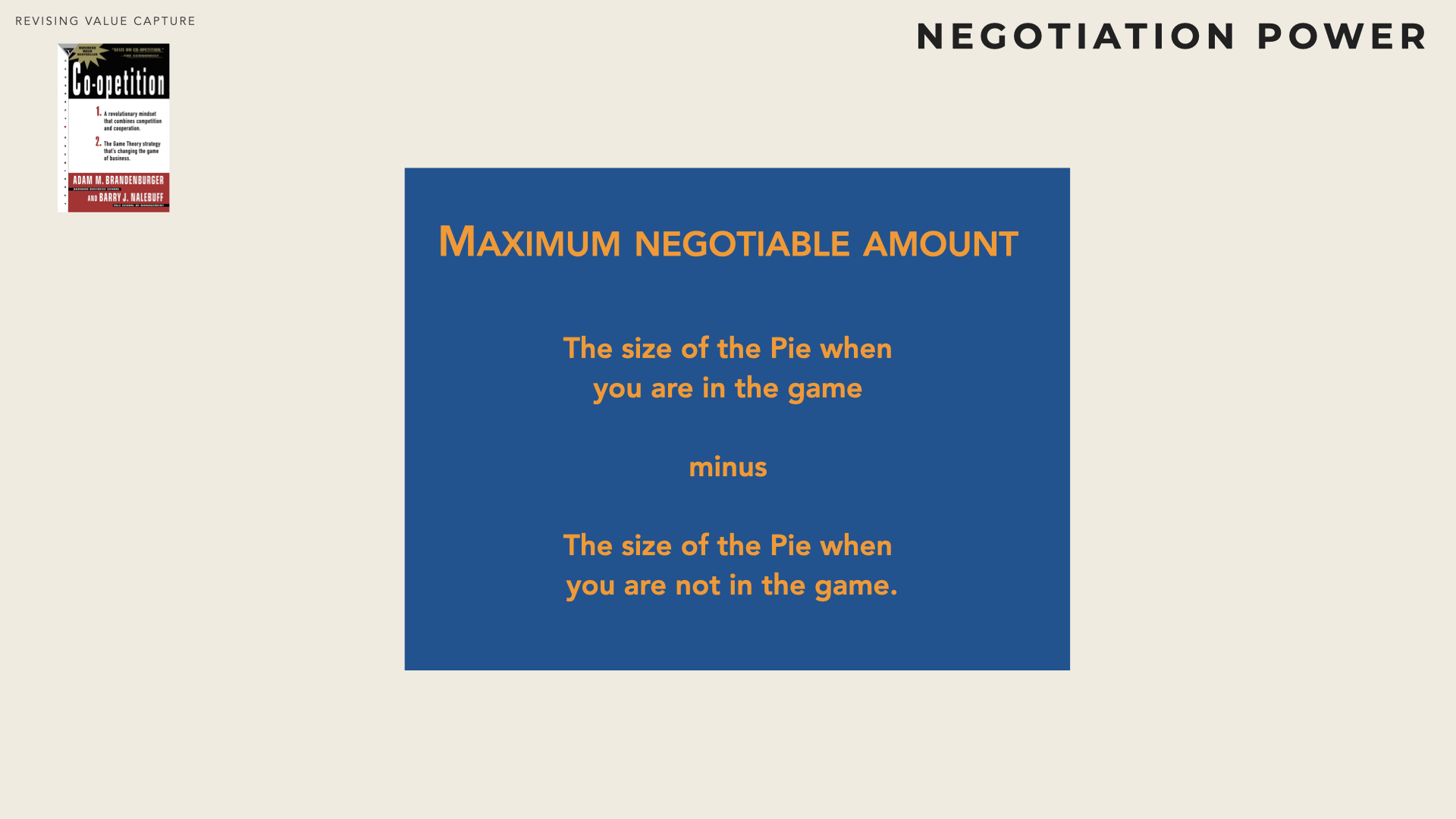
The maximum amount that ‘player A’ can claim equals the difference between the value created by all players and the value created by all players when ‘player A’ is missing. Rational players will not give away to ‘player A’ the value that can be created without ‘player A’.
In a two player-negotiation, the negotiable part can be split evenly.
Lloyd Shapley, a famous game theorist, generalised the concept of solution for a negotiation with n players. The description of the solution, known as Shapley Value, falls beyond the scope of this course.
Grow the Pie before claiming a part of it
The traditional language of business focusses on competition: “outsmarting competition, capturing market shares, beating up suppliers”. Implicitly, the game of business is assimilated to a zero-sum game: competitors have to fail for you to win.
However, as remined by Brandenburger & Nalebuff most business succeed only if others also succeed”.

If total value doubles, you are better off even if you capture less in proportion.
\[V_1 = 0,25 \times P \]
\[V_2 = 0,2 \times ( 2 \times P) = 0,4 \times P \]
Notion of Value Network
The classical view is that firms should operate in a clearly defined segment. Firms that belong to the same segment are competitors and they interact with suppliers & customers.
Brandenburger and Nalebuff ( [Brandenburger96] ) two game theorists, offer a different perspective. The value net is a diagram that serves as a visual representation of the game of business. It locates the various players relative to one another, and identifies the interdependencies among them. It is particularly useful for painting out the ways a relationship between players can combine competition and cooperation.
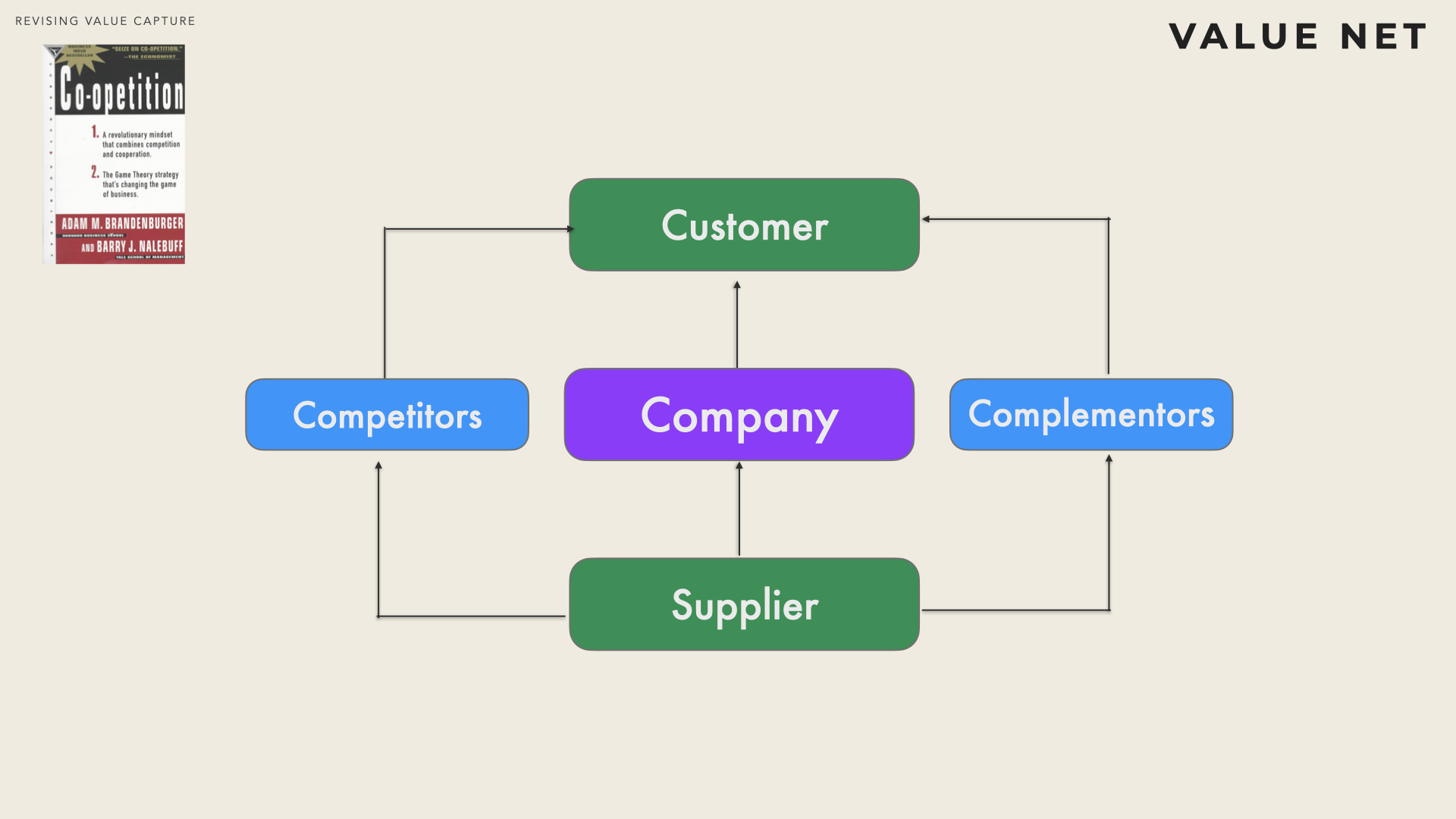
With the Value Net approach, companies can cooperate to grow the pie before they compete to share it. You can often be better off by collaborating with others to make the pie bigger (even if your share remain stable in percentage) rather than claiming a bigger part of a fixed pie (i.e. stealing from somebody else).
„A player is a complementor if its value proposition increases the perceived value of your product / service” [Brandburger96]
Intel and Microsoft are complementors for the PC market. More performant microprocessors as well as more powerful operating systems increase the value of PC. Likewise, content providers (e.g. music producers) are complementors to i-Tunes: the more artists available for download, the more value for end-users.
„Economists call this a network effect (positive externality) or a demand-side economies of scale. When the network effect is present, the value of a product or service is dependent on the total number of customers using it”.
Products or services that highly depend on network effect (i.e. multi-sided models) are very sensitive to quickly achieving the critical mass of users and enjoying positive feedback. Successful Value Propositions can benefit from a bandwagon effect where the rate of adoption becomes proportional to the number of people who are already using the system.
„The opposite effect (i.e. the value of a product decrease with the number of users) is called negative network effect or congestion.”
Sometimes, the same company can launch products that are complementors to their main business. Michelin – the tyre manufacturer – produced maps and touristic guides to encourage car trips and increase wear and tear of tyre.
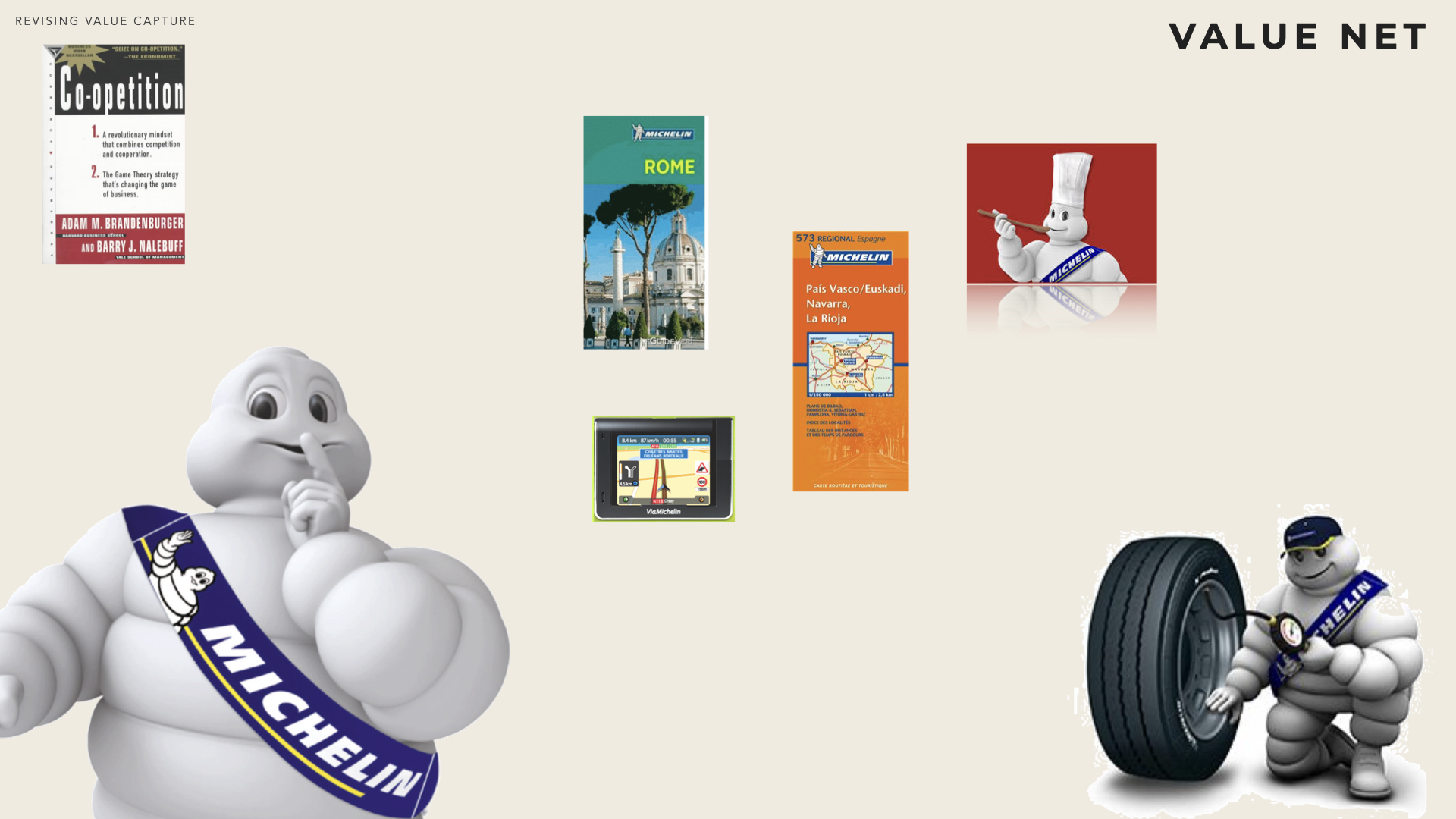
Companies may fail to enter a market for lake of complementors. Brandenburger and Nalebuff mention the examples of Alfa Romeo and Fiat – two Italian car makers – who sought to enter the American market but had to throw the towel because no distribution / repair network was available (and establishing one was far too expensive).
Competition must be understood in its broad sense, that is including incumbent players but also new potential players and substitutes. As already discussed in the chapter about Value Proposition, the key question should be: what else my customers could buy to serve the same need.
Example: The Value Network of TSM
Considering the case of an University (e.g. Toulouse Graduate School of Management in the role of the Company), yield to the following roles:
Customers Students are obvious customers (both current and prospective students). In addition the Families of the students (mainly their parents) would also be considered as customers. Likewise potential Employers should be contemplated as customers (with a different value proposition).
Competitors other Education Institutions (Universities, Schools, etc) are obvious competitors. Other Faculties from the same University would also to some extend be competitors. MOOC (Massive On-Line Open Course) and more generally distance learning should be looked at as competitors.
Complementors Some competitors could as well be complementors through a better alignment of offerings: MOOC, Universities. The availability of Housing, Entertainment, Cultural offers and an efficient Transportation System typically increase the Value Proposition of a University. Likewise the availability of part-time jobs for students or student loans could as well increase the University’s Value Proposition.
Suppliers The Faculty and teachers are obvious suppliers to the University. Book publishers and training material producers would as well be suppliers. In addition, Sponsors, Donators, the State and local administrations should as well be considered as suppliers.
